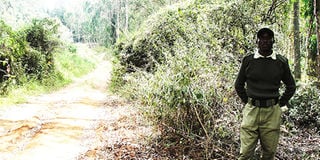Good news from Karura

PHOTO | JOHN FOX
What you need to know:
FACT FILE
History: Karura forest was gazetted in 1929. It lies between Limuru Kiambu and Thika roads.
Attempts were made to degazette large portions of the land after 1990.
However, since the Forest Act of 2005, any excision is very difficult, because it involves a recommendation from the surrounding community and from the Forest Conservation Committee to the KFS Board of Management and, finally, there has to be an endorsement by Parliament.
The Forest Act has made community associations like the Friends of Karura Forest partners in conservation
Access for cars: Off Limuru Road, opposite the Belgium Embassy and through the KFS station off Kiambu Road opposite CID Headquarters.
Pedestrian gates: ICRAF, near the Shell Sports Club, Huruma Village and Old Kiambu Road.
Friends of Karura: For more information about the forest and its amenities, visit the FKF website: www.karurafriends.org.
“So where are we going, Mr John?” asked Peter, the driver.
“Karura Forest.”
“Oh, Wangari Maathai’s forest.”
“Right! But today Shell is donating a building there that will become a public education centre.”
“Oh. So there’s some good news from Karura Forest!”
Peter has a long memory.
It was January 1999 when Wangari Maathai was beaten up by police when she entered Karura to protest against half of it being hived off for private development. But I also understand why he remembered – because it was a grabbing that grabbed the headlines here and around the world, and Wangari Maathai’s name has been associated with all the attempts since then to protect these magnificent 2,500 acres of forest on the northern edge of the city between Limuru and Kiambu roads.
And I was not surprised that Peter had heard no good news from Karura. Because, apart from the grabbing, the place acquired a sinister reputation in the years following Independence.
It was where dead bodies were dumped, where women were raped and where people were carjacked.
But things have changed for the forest. Dramatically and positively.
Last Saturday, the minister of Forestry, Noah Wekesa, launched the Karura Forest Environmental Trust at the Shell Sports Club.
Understandably, it was a morning for congratulatory speeches.
Because the Trust has brought together, with Kenya Shell, the Kenya Forest Service, the Friends of Karura, the Oshwal Education and Relief Board, and the Green Belt Movement.
The two speeches that struck home for me were two rather impromptu ones that came straight from the heart. And the first of them highlighted how the names of two other women should be linked with Wangari Maathai’s when the story of the saving of Karura is told.
Charity Munyasia, the Head of Conservancy of the Kenya Forest Service, recalled a meeting she had some time back with “a rather nice and enthusiastic mzungu lady”.
“This is a good place, this forest,” said the lady. “So good!”
“No, it’s so bad,” insisted Charity.
“But it’s lovely. Can’t we do something about it?” Charity admitted that at the time she hadn’t realised that she was talking to Alice Macaire, the wife of the British High Commissioner.
The something that the two women did was to lobby the support of powerful neighbours of the forest – because Karura is close to the Gigiri UN complex and the embassies of Muthaiga – and to form the Friends of Karura Association.
The Association’s aim is, in conjunction with the Kenya Forestry Service, “to make Karura secure and safe”. Those are the key words.
It looks now that the forest is secure: the threat of the land being taken for other purposes is over.
And the forest is safe: an electric fence now surrounds it and there are plenty of G4S guards, KFS rangers and the Association’s security scouts to protect and guide. Already, there are walkways and nature trails through the forest.
There are waterfalls to see, caves to hide in, a hidden church to find, bird songs to hear – and, of course, the trees to enjoy.
All this, in the last couple of years, has been helped along by the efforts of those Charity laughingly called the “high and mighty”.
But she also reminded us that none of this might have happened if it hadn’t been for the residents of the adjacent Huruma slum.
Back in January 1999 when Karura was ringed by police and GSU with orders to keep Wangari Maathai out, it was residents of Huruma slum who carried her into the forest on their shoulders.
And so I reckon the second speech I am remembering was the most significant of the day. John Chege was invited to say a few words. He is the leader of the Karura Scouts and Guides.
“I am from Huruma,” he said. “I was there that day when we carried Professor Maathai into Karura. And I am mad about conserving this forest.”
John Fox is Managing Director of IntermediaNCG: [email protected]




